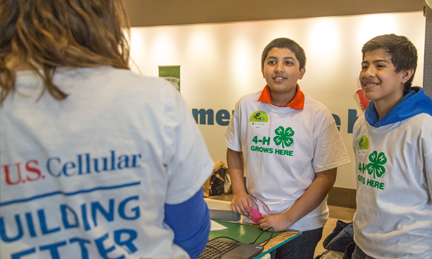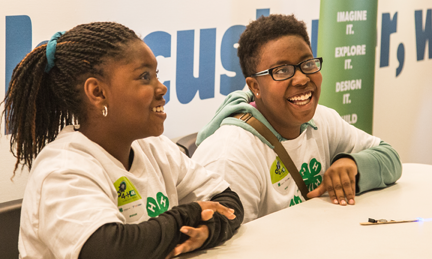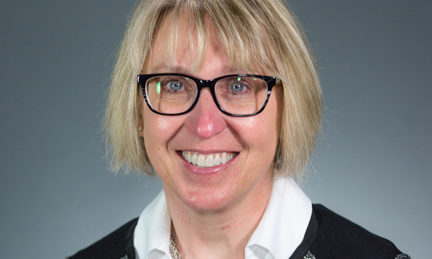
Following the tour, students from the D.C. and Maryland area 4‑H clubs came to the HughesNet facility to experience the preview of the newest 4‑H NYSD project, Incredible Wearables, first hand. This event provides an opportunity for 4‑H to test the Beta version of the year’s challenge. At the start of the event, I presented a general overview of the curriculum, and then we dove into the project kit. The Incredible Wearable project will be the 10th 4‑H National Youth Science Day project hosted by National 4‑H. This year’s project is a fun way to learn about the components that go into making a fitness tracker. The challenge involves building a health monitor with four constraints: size, aesthetics, available components, and time. The goal of the challenge is for youth to apply the engineering design process by analyzing their creation and figuring out ways to refine the design to meet the project constraints.

The challenge started out by teaching the youth how to find their pulse and determine the average for their group. From there we started in on the build process. As with any beta trial run, you will discover things that could be improved or refined. This was the case for not only the youth but for those of us running the event as well. We worked through the challenges, and in the end were successful at getting all the devices powered up and communicating with a mobile device. All of the feedback was collected by 4‑H to improve the devices and provide guidance for 4‑H members across the country on how to prepare for 4‑H NYSD events.
All of the youth teams were able to take their monitor outside where they could have some space to move around. They jumped rope, hula hooped and did jumping jacks to increase their heart rate. The tracker recorded the data and sent it to their mobile device. It was great to see all the youth participating and creating the tracker as a team. They had very different ideas of how to attach the components and were quite creative. One team even made a glove out of felt that worked incredibly well.
This experience helped me to see just how much goes into to creating a project, such as Incredible Wearables. While I have lead 4‑H NYSD curriculum prior to this, I did not give much thought into what it takes to create a project that will be educational, fun, and successful for a large group of youth. The Incredible Wearables project, while a bit difficult to get started, turned out to be a big success that was enjoyed by all. I am grateful to National 4‑H for all the magnificent opportunities I have had so far and am looking forward to the 4‑H NYSD event on October 4th in New York.
With a shared passion for STEM, 4‑H and HughesNet aim to inspire the next generation of scientists by introducing more youth to hands-on, community-based science projects, and 4‑H NYSD does just that! HughesNet is thrilled to play a role in connecting young people from around the world in an exciting, interactive STEM challenge that utilizes engineering principles we integrate into our work every day.
Access to quality science, technology, engineering and math education shouldn’t be determined by where you live. Kids all across the U.S. should have access to hands-on STEM learning. Not only is it important for the development of our youth, but it’s also critical for our country’s future. To help 4‑H reach even more youth, HughesNet sponsored a Raise Your Hand for STEM campaign, giving the ten states with the most votes 100 4‑H NYSD kits. This will allow an additional 10,000 kids across the country to participate in the challenge!
This year’s challenge, Incredible Wearables, designed by the University of Nebraska-Lincoln Extension, offers youth the opportunity to learn how circuits, sensors and health data can be blended with fashion to create a wearable tech product. During the interactive project, these future engineers will work together to design their very own fitness wearable and test their device in real-time by wearing them during brief exercise activities.
“2017 will mark the fourth year of 4‑H NYSD sponsorship for HughesNet — a milestone in our ongoing partnership with 4‑H to promote STEM education nationwide,” said Peter Gulla, senior vice president, marketing, Hughes Network Systems. “Since 2013, HughesNet and 4‑H have helped provide hands-on STEM activities to thousands of youth across the country each year. We are proud to witness the exponential growth of 4‑H NYSD into the world’s largest youth-led science challenge.”
On August 8, Ava Lonneman, our 2017 4‑H Youth in Action STEM pillar winner, hosted a 4‑H National Youth Science Day preview event at Hughes headquarters for local students from Montgomery and Frederick County, Maryland. Ava shared her 4‑H story and helped the young engineering teams design their very own wearable fitness monitor, complete with a programmable Wi-Fi enabled microcontroller and sensors for monitoring data on a smartphone, tablet or laptop. Some participants were so excited about optimizing their health monitor that they opted for a wearable glove to better track movement data! You can watch the highlight video here.
Don’t miss the chance to be part of the 2017 4‑H NYSD event! Click here to order a kit for your club today. For more information on HughesNet’s STEM partnership with 4‑H, please visit www.hughesnet.com/4H.
Check out the new infographic, which perfectly demonstrates why science matters!
“As a third generation 4‑H’er, 4‑H had and continues to have a large impact on my life. As a 10-year member, I gained many life skills from communication to organization to leadership. I will never forget when I was 10 years old and my mother made me do the demonstration contest. I was scared to death and not very happy with her for making me do it, but I thank her almost daily as talking in front of a crowd as only gotten easier. Many of the memories of my childhood come from 4‑H, whether it being sewing with my Gramma or working with my livestock. 4‑H introduced me to Purdue University at an early age which made deciding to go there for college a no-brainer. My husband and I are so excited to be able to share and build new 4‑H experiences with our children. I can’t say enough about what 4‑H did for me and continues to do today.”
“4‑H was HUGE in Texas! Here in Alabama, FFA is bigger, but I feel like giving those kids an extra 6 years in agriculture really solidifies their experiences and encourages them to pursue a future in it. Especially, when you can snag them before they get into sports! My goal is to start an after-school program through 4‑H, that way inner city kids can get exposure every day versus once a year. We did a tremendous amount of service through 4‑H, and I think that is something lost to upcoming generations. Although the animal projects and judging teams were what consumed my time, I think the civic responsibility is what has made a lasting impression on my life. I tell young people not to ever feel bad about the time that they give to someone else because there is not much that compares to it in value.”
Learn more about the 4‑H and American Farm Bureau Federation partnership.

The Kentucky delegation centered their project around addressing the low literacy rate among citizens in Louisville, Ky. They will partner with local school systems, clubs and organizations to provide programming designed to improve the literacy rates in adults.

The Alabama delegation developed a leadership program consisting of community service, leadership workshops, and fundraising to benefit local communities. The delegation will partner with extension, local high schools and colleges, recreation centers, and community members to develop this program.
The delegation of the Northeast District of Oklahoma created a career planning program for youth, ages 15-18, who will soon age out of the foster care system. The group plans to work with a local shelter and local government services in Tulsa, Okla., to establish this program.
The Kansas delegation developed a program to teach community members how to grow their own food, select the right food from a food pantry, and cook healthy meals. The program will also focus on teaching about the agriculture industry. The Kansas delegation also received an additional $500 mini-grant for having the most outstanding overall community action plan.
The South Carolina delegation will establish a program for elementary and middle school students from low-income families to receive school supplies. The delegation will work with other community partners to promote the program and gather needed supplies.
The Southeast Ohio delegation will create a program to provide resources to the homeless. The delegation will hold a competition between 4‑H Clubs to bring in non-perishable items, clothing and personal hygiene products.
4-H Alumni nationwide have a story to tell and a testimony to share when it comes to how 4-H has changed their lives, shaped their personalities, and opened up doors, getting them to where they are today. As we continue our celebration of successful women and men who are proud to say they are 4-H Grown, we highlight the 4-H alum who are now members of American Farm Bureau Federation, a proud partner and advocate for 4-H!
“I am a proud 4‑H’er! 4-H taught me so many things! How to teach, how to do reports and give reasons. It taught me how to win with good sportsmanship and how to lose with grace. It taught me how to pack a trailer for a week long show & how to make my best even better! I’m so thankful for this program, and it’s why I’m still involved as an Extension Council member, fair board member, and parent today!”
“For me, 4-H was my very first introduction to agriculture. I learned the responsibility of taking care of another being and started gaining some business understanding. I knew how to balance a checkbook before I was in high school because of my 4-H project. But I also learned about making presentations and the importance of giving back to your community.”
When it comes to creating success in one’s career, sometimes the greatest obstacle can be ourselves. Lori Dawson has experienced this challenge firsthand. While her journey in the field of engineering began with the desire to solve complex problems by interacting and communicating with others, speaking up and using her voice was a struggle. As senior director of Engineering and Network Operations at U.S. Cellular, Dawson admits that very early in her career, she struggled with having confidence in her ability.
“I would often know the answer,” she recalls, “but hang back and allow others to speak and then I would speak up in support of their answer.”
Now, after learning to “jump in and speak up,” Lori Dawson understands the value of growing confidence in young people, and she is committed making learning opportunities available at an early age through the 4-H/U.S. Cellular partnership.
She shared her insights on why it’s important for organizations to attract diversity in science, technology, engineering and math (STEM) fields, and how 4-H and U.S. Cellular are working collectively on these efforts.
What do you think are the current barriers to achieving more diversity in STEM career fields?
Lori Dawson (LD): I believe one of the barriers to achieving more diversity in STEM career fields is the opportunities available at a young age. Today there are many opportunities to participate in various sporting events for young children but very limited opportunities for those interested in STEM. Children need STEM activities that are fun, challenging and rewarding to attract more diversity to the field.
What can organizations do to get more girls interested in STEM careers?
LD: I believe organizations can assist with attracting girls to STEM careers by allowing girls into the organization for job shadowing or internships. Also, organizations should strengthen their involvement in the community, bringing to life what STEM careers are available and the rewards that come with those careers.

Why do you think the 4-H/U.S. Cellular partnership is critical for sparking STEM interest in youth? How has the partnership been successful?
LD: I see the partnership between 4-H and U.S. Cellular as critical for the future of our youth and the success of U.S. Cellular. From a 4-H perspective, U.S. Cellular can assist 4-H in bringing to life STEM opportunities and U.S. Cellular will benefit from the future leaders that 4-H is developing as they are our next technology leaders.
Recently, U.S. Cellular has ventured outside of their STEM partnership with 4-H, now serving as a sponsor of the 2017 4-H Youth in Action Award Citizenship Pillar. How does the topic of community service align with U.S. Cellular’s mission and values as an organization?
LD: Community service and involvement are the core to who U.S. Cellular is. The Engineering teams at U.S. Cellular live and work in the markets they serve. All associates are encouraged to get engaged in the communities where they live and work.
How do you think 4-H is preparing today’s young people, particularly girls, to be leaders in life?
LD: I believe 4-H has a history of developing strong leadership skills by developing, communication, and confidence in our youth. 4-H assists our youth in developing and practicing critical thinking skills. 4-H not only does this for young girls but all young people engaged in 4-H.

What are your thoughts on ways we can encourage young women to pursue entrepreneurial and leadership opportunities?
LD: I think from a very young age we need to encourage young girls to actively participate in science and math classes. To reward their participation and challenge them to think differently. We also need to look for and encourage opportunities for young girls to get involved in activities such as 4-H, Lego League, etc.
What is your vision for the next generation of women in STEM and leadership?
LD: I see the next generation of women in STEM leading the way for significant growth in technology. The technology marketplace is growing at a pace faster than ever, and I see women developing the vision and leading through the technology evolution.
The 4‑H Food Smart Families program helps to empower families through food knowledge and education to build sustainable solutions that confront food insecurity and improve overall health. Driven by 4‑H teen leaders, 4‑H Food Smart Families programming focuses on helping peers and their families learn about food – how to budget for it, use it, cook it and make choices that contribute toward their health and well-being.
For two consecutive years, U.S. Cellular has proudly supported National 4‑H Council and 4‑H National Youth Science Day (NYSD). It is a wonderful way to introduce young people to the wide range of ways that Science, Technology, Engineering and Math (STEM) education is used every day in hundreds of careers. When our associates spend time with 4‑H youth in our local communities, our hope is that the kids see how what they are learning today can lead to fun and interesting careers down the road.
In my engineering role at U.S. Cellular, I get to work on many unique and challenging projects, and it’s the part of my job that I love the most. Wireless technology moves so fast that there is always something new to learn or a problem to solve. And while you may think that we engineers are sitting by ourselves at a computer all day, that couldn’t be further from the truth. I get to work with amazing people every day, and we combine our STEM knowledge together to overcome challenges that we face – all with the goal of ensuring that our customers have access to a fast data network and that their phones work when and where they need it.

This year’s 4‑H NYSD theme of Drone Discovery is especially relevant in the wireless industry. As the industry learns more about the capability of drones in real-world applications, we are watching closely to determine how we can implement this technology into our work. Possibilities include using drones to assess damage to cell sites when roads are closed due to severe weather, testing network signals on high-rise buildings, and routine tower inspections. As someone who owns two drones, I am thrilled that 4‑H youth are learning about them now, and I can’t wait to see all of the new ways they will show us how they can be used in the future.
Over the past month, U.S. Cellular associates have worked with hundreds of 4‑H youth at eight 4‑H NYSD Drone Discovery events, and seeing the creativity and energy that the young people bring has been very inspiring. One of the most fun parts of working with drones is just seeing what you can make them do. Having young people with a strong background in STEM education is critical to the ongoing evolution of how we create and use technology, including drones.